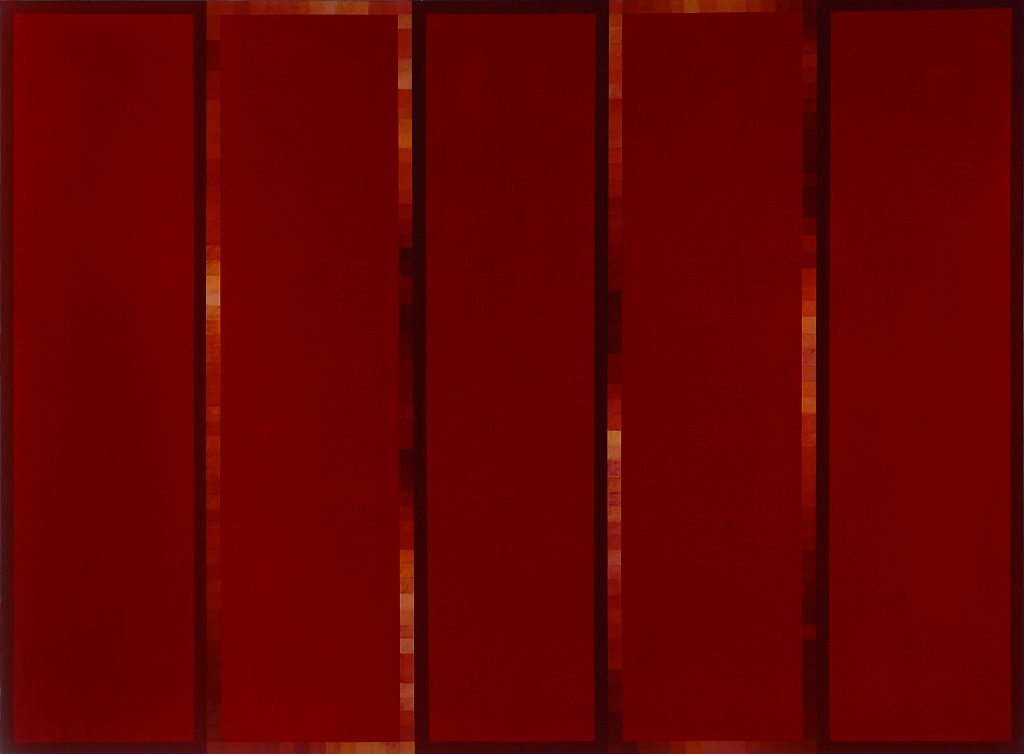
TarraWarra Museum of Art’s three new exhibitions bring together contemporary art with iconic furniture
Share
Opening on 23 March and running through to 14 July 2024, TarraWarra Museum of Art presents three distinct yet interconnected exhibitions. Featuring new work by contemporary Australian artists Peter Atkins and Dana Harris, a collection of furniture and lighting by renowned modernist sculptor and designer Clement Meadmore, and a collection of predominantly abstract paintings and sculptures by Australian artists from the Museum’s own collection curated by Anthony Fitzpatrick, the exhibitions collectively explore the systems at play within art and design.

embroidered on plastic grids, 34 x 37 cm. Courtesy of the artist
SUPERsystems Peter Atkins and Dana Harris
SUPERsystems is the first joint exhibition from Melbourne-based contemporary artists Peter Atkins and Dana Harris. Both Atkins and Harris share conceptual and formal concerns, employing geometry, repetition and seriality as a means to reimagine the everyday world.

Courtesy of the artist, Tolarno Galleries, Melbourne and GAGProjects, Adelaide
In SUPERsystems, which presents major new works by the artists, we see the highly distinctive visual language of each artist feeding off of the other. Atkins’ work materialises as a deconstruction of American designer Maurice Binder’s opening title sequence for the first James Bond film Dr. No (1962). Presented across 92 individual paintings in four horizontal rows, each frame of the original animation is revealed as a unique, abstract composition, like a tangible, stop-motion version of the original.

embroidered on plastic grids, 34 x 37 cm. Courtesy of the artist
Harris presents a new project titled fancywork, which emerged from her experience of walking the deserted streets of the Melbourne CBD during the COVID-19 lockdowns. Inspired by the subtle shifts and spatial relationships in the built environment. Similarly to Atkins, Harris uses repetition and pattern to communicate her intent. Here, in SUPERsystems the artist presents 22 intricately hand-embroidered panels which use repetition and complex patterns to express the new rhythms and connections she observed while exploring the city at a standstill.

92 panels: 28 x 46 cm each. Courtesy of the artist, Tolarno Galleries, Melbourne and GAGProjects, Adelaide
The Industrial Design of Clement Meadmore: The Harris/Atkins Collection
Clement Meadmore is one of the most important Australian sculptors of the twentieth century. Acknowledged not only within the art community, Meadmore was a significant and pioneering figure within the history of Australian modernist design.

Harris/Atkins Collection
“Meadmore’s distinctive visual language was often informed by the modernist principles of the Bauhaus and the De Stijl movement—a source of inspiration shared by Harris and Atkins” says Anthony Fitzpatrick, TarraWarra Museum of Art curator.

36 x 112 x 50 cm. Harris/Atkins Collection
For this exhibition, Atkins and Harris present their own collection of Meadmore pieces which they’ve meticulously assembled over the past quarter century. In doing so, The Industrial Design of Clement Meadmore highlights Meadmore’s highly distinctive approach to industrial design and his remarkable ability to manipulate the most basic, readily available materials—steel rod, cotton cord, glass, sheet metal, canvas and thin plywood—into functional, innovative and durable objects.

plastic-coated steel, vinyl and rubber, 92 x 41 x 57 cm. Harris/Atkins Collection
Meadmore’s iconic chairs, tables and lighting are the most important and comprehensive collection of his industrial design in public or private hands. Presented for the first time in its entirety, the Harris/Atkins Collection provides a unique opportunity to survey the breadth and depth of Meadmore’s singular design language.
Systems and Structures: A Focus on the TarraWarra Museum of Art Collection
The third exhibition in this triangulation of art and design features works by a range of Australian artists who employ patterns, geometry, modules and repetition as key elements in their creative process.

TarraWarra Museum of Art collection. Gift of Eva Besen and Marc Besen AO 2001
“The third exhibition of predominantly abstract painting and sculpture by Australian artists from the Museum’s own collection, deepens this sustained exploration of the formal and conceptual systems and principles that guide creative practices and artmaking,” Fitzpatrick says.

TarraWarra Museum of Art collection. Gift of Eva Besen AO and Marc Besen AO.
Donated through the Australian Government’s Cultural Gifts Program 2012 © Hilarie Mais
The exhibition includes works by Robert Hunter, Clement Meadmore, Hilarie Mais, Rosalie Gascoigne, Howard Arkley, Lesley Dumbrell, Mark Galea, Robert Jacks, Callum Morton, John Nixon and Robert Owen.

TarraWarra Museum of Art collection. Purchased 2007
Art, music and conversation enrich the exhibition experience
Taking place Saturday 3 to Sunday 5 May, halfway through the exhibition period, is the 2024 TarraWarra Festival. Richard Tognetti and the Australian Chamber Orchestra will present a performance that responds to the Systems and Structures exhibition.
On Sunday 21 April 2024, TarraWarra Museum of Art will host an Afternoon with Peter Atkins and Dana Harris, which presents a unique opportunity to gain direct insights into each artists’ practices as well as the work and legacy of Clement Meadmore.
Lead image: Peter Atkins, Dr. No (after Maurice Binder) 2020–23 (detail), synthetic polymer paint on board, 92 panels: 28 x 46 cm each. Courtesy of the artist, Tolarno Galleries, Melbourne and GAGProjects, Adelaide
Check out more art such as Lionel Bawden’s sculptures at Karen Woodbury Gallery
You Might also Like



















